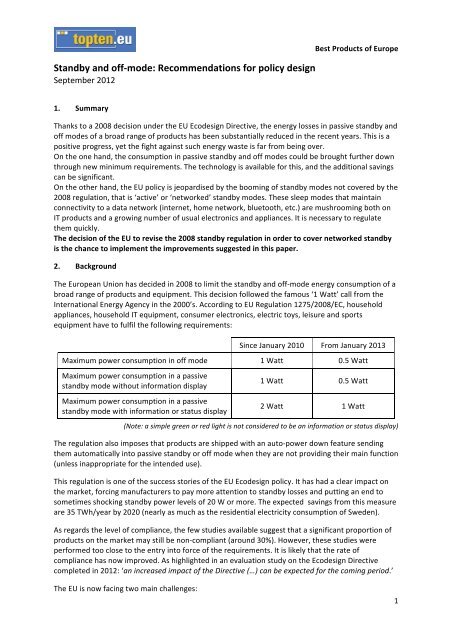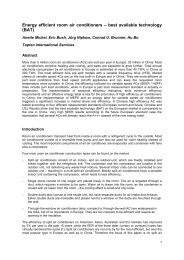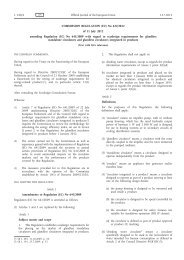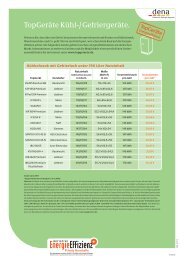Standby and off-‐mode: Recommendations for policy ... - Topten.eu
Standby and off-‐mode: Recommendations for policy ... - Topten.eu
Standby and off-‐mode: Recommendations for policy ... - Topten.eu
You also want an ePaper? Increase the reach of your titles
YUMPU automatically turns print PDFs into web optimized ePapers that Google loves.
Best Products of Europe <br />
<strong>St<strong>and</strong>by</strong> <strong>and</strong> <strong>off</strong>-<strong>‐mode</strong>: <strong>Recommendations</strong> <strong>for</strong> <strong>policy</strong> design <br />
September 2012 <br />
1. Summary <br />
Thanks to a 2008 decision under the EU Ecodesign Directive, the energy losses in passive st<strong>and</strong>by <strong>and</strong> <br />
<strong>off</strong> modes of a broad range of products has been substantially reduced in the recent years. This is a <br />
positive progress, yet the fight against such energy waste is far from being over. <br />
On the one h<strong>and</strong>, the consumption in passive st<strong>and</strong>by <strong>and</strong> <strong>off</strong> modes could be brought further down <br />
through new minimum requirements. The technology is available <strong>for</strong> this, <strong>and</strong> the additional savings <br />
can be significant. <br />
On the other h<strong>and</strong>, the EU <strong>policy</strong> is jeopardised by the booming of st<strong>and</strong>by modes not covered by the <br />
2008 regulation, that is ‘active’ or ‘networked’ st<strong>and</strong>by modes. These sleep modes that maintain <br />
connectivity to a data network (internet, home network, bluetooth, etc.) are mushrooming both on <br />
IT products <strong>and</strong> a growing number of usual electronics <strong>and</strong> appliances. It is necessary to regulate <br />
them quickly. <br />
The decision of the EU to revise the 2008 st<strong>and</strong>by regulation in order to cover networked st<strong>and</strong>by <br />
is the chance to implement the improvements suggested in this paper. <br />
2. Background <br />
The European Union has decided in 2008 to limit the st<strong>and</strong>by <strong>and</strong> <strong>off</strong>-<strong>‐mode</strong> energy consumption of a <br />
broad range of products <strong>and</strong> equipment. This decision followed the famous ‘1 Watt’ call from the <br />
International Energy Agency in the 2000’s. According to EU Regulation 1275/2008/EC, household <br />
appliances, household IT equipment, consumer electronics, electric toys, leisure <strong>and</strong> sports <br />
equipment have to fulfil the following requirements: <br />
Since January 2010 <br />
From January 2013 <br />
Maximum power consumption in <strong>off</strong> mode 1 Watt 0.5 Watt <br />
Maximum power consumption in a passive <br />
st<strong>and</strong>by mode without in<strong>for</strong>mation display <br />
Maximum power consumption in a passive <br />
st<strong>and</strong>by mode with in<strong>for</strong>mation or status display <br />
1 Watt 0.5 Watt <br />
2 Watt 1 Watt <br />
(Note: a simple green or red light is not considered to be an in<strong>for</strong>mation or status display) <br />
The regulation also imposes that products are shipped with an auto-‐power down feature sending <br />
them automatically into passive st<strong>and</strong>by or <strong>off</strong> mode when they are not providing their main function <br />
(unless inappropriate <strong>for</strong> the intended use). <br />
This regulation is one of the success stories of the EU Ecodesign <strong>policy</strong>. It has had a clear impact on <br />
the market, <strong>for</strong>cing manufacturers to pay more attention to st<strong>and</strong>by losses <strong>and</strong> putting an end to <br />
sometimes shocking st<strong>and</strong>by power levels of 20 W or more. The expected savings from this measure <br />
are 35 TWh/year by 2020 (nearly as much as the residential electricity consumption of Sweden). <br />
As regards the level of compliance, the few studies available suggest that a significant proportion of <br />
products on the market may still be non-‐compliant (around 30%). However, these studies were <br />
per<strong>for</strong>med too close to the entry into <strong>for</strong>ce of the requirements. It is likely that the rate of <br />
compliance has now improved. As highlighted in an evaluation study on the Ecodesign Directive <br />
completed in 2012: ‘an increased impact of the Directive (…) can be expected <strong>for</strong> the coming period.’ <br />
The EU is now facing two main challenges: <br />
1
Best Products of Europe <br />
• Bringing the power consumption of passive st<strong>and</strong>by <strong>and</strong> <strong>off</strong> modes further down. <br />
• Regulating the currently excluded ‘active st<strong>and</strong>by’ modes (also called ‘networked <br />
st<strong>and</strong>by’) <strong>for</strong> products connected to networks. These modes are rapidly exp<strong>and</strong>ing <strong>and</strong> need <br />
more power to maintain a constant connectivity to a network (internet, home network, etc.) <br />
<strong>and</strong> the possibility to reactivate the product automatically through network signals. <br />
The EU has started discussions on networked st<strong>and</strong>by <strong>and</strong> is expected to adopt some provisions <strong>for</strong> <br />
these modes by end of 2012 through a revision of the regulation 1275/2008/EC. <br />
3. Best available Technologies <br />
The measurement of the passive st<strong>and</strong>by <strong>and</strong> <strong>off</strong> mode consumption of electricity-‐using products is <br />
well st<strong>and</strong>ardised <strong>and</strong> easily available, especially since the EU Ecodesign regulation makes it binding <br />
to indicate such values in the technical documentation. <br />
Several selections of the best products presented on <strong>Topten</strong> Europe (www.topten.<strong>eu</strong>) mention the <br />
passive <strong>and</strong>/or <strong>off</strong> mode consumption. As of September 2012, here is an overview of the levels found <br />
on <strong>Topten</strong> Europe products: <br />
Product group TVs Monitors <br />
Number of products <br />
in <strong>Topten</strong> sample <br />
Average <strong>off</strong>-<strong>‐mode</strong> <br />
power (W) <br />
Best per<strong>for</strong>mer <strong>off</strong>-mode<br />
(W) <br />
Average passive <br />
st<strong>and</strong>by (W) <br />
Best per<strong>for</strong>mer <br />
passive st<strong>and</strong>by (W) <br />
% of products with a <br />
hard-‐<strong>off</strong> switch or <br />
quasi-‐0 W mode <br />
DVD <br />
players* <br />
Washing <br />
machines <br />
c<strong>off</strong>ee <br />
machines <br />
inkjet <br />
printers <br />
laser <br />
printers <br />
luminaires <br />
118 48 11 24 24 19 37 61 <br />
0.34 0.25 0.36 0.34 <br />
0.1 0.05 0.2 0.1 <br />
0.24 0.41 0.51 1.3 0.43 0.47 <br />
0.1 0.1 0.2 0.75 0.15 0.2 <br />
3% 15% 29% 24% 38% 43% <br />
(* Data <strong>for</strong> DVD Players are extracted from <strong>Topten</strong> Switzerl<strong>and</strong> <strong>and</strong> not <strong>Topten</strong> Europe) <br />
These figures are not representative of the entire market but give a good indication of what <br />
manufacturers are able to do. It appears that <strong>off</strong> <strong>and</strong> passive st<strong>and</strong>by modes can technically go below <br />
0.25 W. This is probably true <strong>for</strong> a wide range of products. <br />
Concerning active st<strong>and</strong>by <strong>and</strong> sleep modes, it is not yet m<strong>and</strong>atory in the EU to declare the <br />
consumption according to harmonised methods, so comparable data is more difficult to find. On <br />
<strong>Topten</strong> Europe selections, figures collected <strong>for</strong> the sleep mode of printers as of September 2012 are: <br />
Product group inkjet printers laser printers <br />
Number of products in <strong>Topten</strong> sample 19 103 <br />
Average sleep mode power (W) 1.17 3.84 <br />
Best per<strong>for</strong>mer sleep mode (W) 0.7 0.8 <br />
Note: the characteristics of the reactivation options available in these st<strong>and</strong>by modes is not known (e.g. it can be <br />
reactivation from a computer but not necessarily from a wi-‐fi connexion) <br />
2
Best Products of Europe <br />
More specific data on best per<strong>for</strong>mers in networked st<strong>and</strong>by can be extracted from the 2011 EU <br />
Ecodesign preparatory study on networked st<strong>and</strong>by (Lot 26). Examples of best available technologies <br />
are provided <strong>for</strong> a range of product categories: <br />
Product group Desktop PC Laptop <br />
Best per<strong>for</strong>mer <strong>for</strong> network st<strong>and</strong>by <br />
requiring low network reactivity (W) <br />
Best per<strong>for</strong>mer <strong>for</strong> network st<strong>and</strong>by <br />
requiring high network reactivity -‐ <br />
very fast reactivation time (W) <br />
Internet <br />
gateway <br />
Set top box <br />
< 1.5 < 1 < 2 < 2.5 <br />
Smart <br />
phones <br />
6.3 3.2 < 1 <br />
The most advanced efficient networked st<strong>and</strong>by modes can be found in the notebook <strong>and</strong> mobile <br />
phone technologies. They show how network connectivity <strong>and</strong> reactivity can be maintained at a very <br />
low power cost. Data presented at a workshop organised by the IEA in May 2012 mentioned <br />
networked st<strong>and</strong>by power levels as low as 0.03 W <strong>for</strong> the iPhone 4 <strong>and</strong> 0.3 W <strong>for</strong> some notebooks. <br />
4. Market situation in Europe <br />
Market evolution regarding st<strong>and</strong>by <strong>and</strong> <strong>off</strong> mode energy consumption is essentially driven by <br />
regulation. Low st<strong>and</strong>by consumption has never been a driver <strong>for</strong> differentiation on the market. The <br />
st<strong>and</strong>by consumption is usually not indicated on the product advertising material nor on the Energy <br />
Labelling. (The only exception is in the recently introduced EU Energy Label <strong>for</strong> TVs, which highlights <br />
through a pictogram whether the product includes a hard-‐<strong>off</strong> switch or very low st<strong>and</strong>by mode; <br />
however impact on consumers of this provision is not yet known). For consumers, the st<strong>and</strong>by <br />
consumption is not a criteria <strong>for</strong> purchasing products. Awareness raising towards consumers has <br />
rather been focused on using ‘st<strong>and</strong>by-‐killers’ at home. <br />
Fortunately, the growing success of mobile <strong>and</strong> portable products has <strong>for</strong>ced manufacturers to find <br />
technological solutions <strong>for</strong> limiting the energy consumption of these products in all modes due to the <br />
limitation of batteries. However, the deployment of these technologies to non-‐portable products has <br />
not naturally happened, hence the need <strong>for</strong> strong regulation. <br />
Actually, a counter-‐productive trend is the belief that consumers always want shorter <strong>and</strong> shorter <br />
reactivation times to have all their products immediately ready <strong>for</strong> use. This drives some <br />
manufacturers to induce higher energy consumptions by providing ‘quick-‐start’ features or very fast <br />
reactivation from st<strong>and</strong>by, requiring more power. For instance, an internet-‐TV can consume less than <br />
1 W in normal st<strong>and</strong>by but more than 20 W in a quick-‐start mode providing faster reactivation. Such <br />
trend <strong>and</strong> modes put at risk the credibility of the EU <strong>policy</strong>. <br />
5. Energy consumption <strong>and</strong> saving potentials <br />
According to the impact assessment study accompanying EU Ecodesign Regulation 1275/2008 on <br />
st<strong>and</strong>by, the EU had an installed base of electronic products <strong>and</strong> appliances in the household <strong>and</strong> <br />
<strong>off</strong>ice sectors of approximately 3.7 billion units in 2005. This stock is assumed to grow to 4.6 billion <br />
by 2020. <br />
In <strong>off</strong> <strong>and</strong> passive st<strong>and</strong>by conditions, this stock consumed 47 TWh/year in 2005. This figure should <br />
fall to 14 TWh/year by 2020 thanks to regulation 1275/2008. <br />
The energy consumption of networked st<strong>and</strong>by conditions is more difficult to grasp, as many <br />
networked products currently do not include such a low-‐power mode when they maintain <br />
connection to a network (in fact they stay in on-<strong>‐mode</strong> or in a slightly less consuming idle-<strong>‐mode</strong>). The <br />
Ecodesign preparatory study on networked st<strong>and</strong>by (completed in 2011) considered that the stock <br />
3
Best Products of Europe <br />
currently requires about 50 TWh/year to maintain network reactivity, <strong>and</strong> this should grow up to 90 <br />
TWh/year by 2020 if no action is taken. Through regulation <strong>for</strong>cing networked equipment to go to <br />
some low networked st<strong>and</strong>by modes, this additional <strong>for</strong>ecasted consumption of 40 TWh/year could <br />
be avoided cost-‐effectively. <br />
The urgency to regulate networked st<strong>and</strong>by appears very clearly in these figures. The EU must <br />
quickly finalise <strong>and</strong> adopt requirements in this field <strong>and</strong> grasp the 40 TWh per year savings potential. <br />
It is also arguable that consumption in <strong>off</strong> <strong>and</strong> passive st<strong>and</strong>by modes could be further decreased. An <br />
electricity-‐using product that is used 2 hours per day will be in st<strong>and</strong>by or <strong>off</strong> mode 8,000 hours per <br />
year. A (seemingly modest) difference of 0.5 Watt in the latter modes has a yearly consequence of 4 <br />
kWh. Applied to the 30 energy-‐using products that can be found in a typical house nowadays, it <br />
represents 120 kWh / year, which is as much as what some A+++ fridges consume yearly. <br />
Based on rough own calculations, an additional limitation of <strong>off</strong> <strong>and</strong> passive st<strong>and</strong>by in regulation <br />
1275/2008 at the level of 0.25 W would save an additional 6 to 7 TWh per year in the EU. <br />
6. Political instruments <strong>and</strong> initiatives <br />
EU Ecodesign regulations related to <strong>off</strong> <strong>and</strong> st<strong>and</strong>by modes: <br />
-‐ Horizontal Ecodesign Regulation 1275/2008/EC (see point 2 above) <br />
-‐ Revision of Ecodesign Regulation 1275/2008/EC to cover networked st<strong>and</strong>by (to come) <br />
-‐ In some other product-‐specific Ecodesign regulations, more tailored requirements have been set <strong>for</strong> <br />
the <strong>off</strong> <strong>and</strong> st<strong>and</strong>by consumption of some products. Namely: <br />
• TVs: <strong>off</strong>-<strong>‐mode</strong> is limited to 0.3 W <strong>and</strong> the requirements of the 2 nd tier of regulation <br />
1275/2008 <strong>for</strong> passive st<strong>and</strong>by have been en<strong>for</strong>ced earlier (2011). <br />
• Power supplies <strong>and</strong> chargers: the no-‐load condition is limited to 0.3 W or 0.5 W <br />
(depending on the characteristics of the device) <br />
• Washing machines <strong>and</strong> dishwashers: the consumption in st<strong>and</strong>by <strong>and</strong> <strong>off</strong> modes is <br />
included in the calculation of the energy efficiency index, which is the basis <strong>for</strong> the minimum <br />
Ecodesign requirements <br />
• Specific requirements are also excepted <strong>for</strong> Ecodesign regulations to come soon <strong>for</strong> <br />
computers, servers, tumble driers, luminaires, etc. <br />
Energy labels <strong>and</strong> consumer in<strong>for</strong>mation: <br />
In<strong>for</strong>mation to consumers on st<strong>and</strong>by consumption of products is very limited in Europe. <br />
At the point of sale, the only existing m<strong>and</strong>atory requirement is <strong>for</strong> TV <br />
manufacturers to indicate through a pictogram on the Energy Label (introduced in <br />
2011) whether models include a hard-‐<strong>off</strong> switch or quasi-‐0 Watt mode (i.e. below <br />
0.01 W). <br />
On all other existing EU Energy labels, the consumption in st<strong>and</strong>by <strong>and</strong>/or <strong>off</strong> <br />
mode is not displayed. <br />
However, manufacturers of products covered by Ecodesign regulations have to declare the passive <br />
st<strong>and</strong>by <strong>and</strong> <strong>off</strong> mode consumption of their products in the product technical fiche (e.g. <strong>for</strong> set top <br />
boxes, washing machines, dishwashers) <strong>and</strong> sometimes on free-‐access websites (e.g. <strong>for</strong> TVs, <br />
domestic air-‐conditioners, fans). But this requires from consumers to look <strong>for</strong> in<strong>for</strong>mation be<strong>for</strong>e <br />
their purchase <strong>and</strong> this is not always simple to find as this in<strong>for</strong>mation is not centralised. <br />
4
Best Products of Europe <br />
7. <strong>Recommendations</strong> regarding <strong>policy</strong> design <br />
In the coming revision of horizontal Ecodesign Regulation 1275/2008/EC: <br />
• Addition of a new tier limiting <strong>off</strong>-<strong>‐mode</strong> <strong>and</strong> passive st<strong>and</strong>by to 0.25 Watt by 2015. <br />
• M<strong>and</strong>atory requirement <strong>for</strong> products that need to maintain network connectivity to go to <br />
a low power network st<strong>and</strong>by mode after the shortest possible time of no-‐user interaction <br />
(<strong>and</strong> maximum 20 minutes). <br />
• For networked products needing very fast reactivation (such as internet/phone gateways), <br />
the power consumption of the networked st<strong>and</strong>by mode should be limited to 6 Watt in a first <br />
tier, <strong>and</strong> 4 Watt in a longer-‐term step. <br />
• For networked products that do not need very fast reactivation, the networked st<strong>and</strong>by <br />
mode should be limited to 2 Watt in a first tier, <strong>and</strong> manufacturers could be challenged to <br />
achieve 1 Watt in the longer-‐term. <br />
Features such as ‘quick start’ should be also covered by these power limits. <br />
• In addition to that, it would be sound <strong>policy</strong> to provide users with more control over the <br />
functioning <strong>and</strong> power management of their networked products (through easy disabling <strong>and</strong> <br />
time-‐programming of network features, switches to send products into passive st<strong>and</strong>by, etc.). <br />
This would optimise the opportunities to save energy at the level of the user. Suggestions <br />
made by European consumer <strong>and</strong> environmental NGOs should be supported (see references). <br />
In the coming revisions of Energy Labelling regulations: <br />
• Indication of the st<strong>and</strong>by consumption on energy labels could be considered. As a display <br />
in 7 A-‐G classes would not be ideal, another option could be envisaged (e.g. indication of the <br />
power value in Watt, or pictogram to reward front-‐runners such as in the TV label). <br />
• M<strong>and</strong>atory product characteristics to be provided in technical fiches or free-‐access <br />
websites should be centralised to facilitate consumer in<strong>for</strong>mation <strong>and</strong> comparison between <br />
products. <br />
8. References <strong>and</strong> Links <br />
Most efficient products of Europe: <br />
www.topten.<strong>eu</strong> <br />
In<strong>for</strong>mation on the EU Ecodesign process: <br />
www.coolproducts.<strong>eu</strong> <br />
COMMISSION REGULATION (EC) No 1275/2008 of 17 December 2008 implementing Directive <br />
2005/32/EC of the European Parliament <strong>and</strong> of the Council with regard to ecodesign requirements <br />
<strong>for</strong> st<strong>and</strong>by <strong>and</strong> <strong>off</strong> mode electric power consumption of electrical <strong>and</strong> electronic household <strong>and</strong> <br />
<strong>off</strong>ice equipment <br />
http://<strong>eu</strong>r-‐lex.<strong>eu</strong>ropa.<strong>eu</strong>/LexUriServ/LexUriServ.do?uri=OJ:L:2008:339:0045:0052:EN:PDF <br />
• Accompanying document: IMPACT ASSESSMENT C(2008) 8424 final / SEC(2008) 3070 <br />
http://ec.<strong>eu</strong>ropa.<strong>eu</strong>/energy/efficiency/ecodesign/doc/legislation/sec_2008_3071_impact_assesmen<br />
t_en.pdf <br />
• Accompanying GUIDELINES <br />
5
Best Products of Europe <br />
http://ec.<strong>eu</strong>ropa.<strong>eu</strong>/energy/efficiency/ecodesign/doc/legislation/guidelines_<strong>for</strong>_smes_1275_2008_<br />
okt_09.pdf <br />
Working Document from the European Commission on networked st<strong>and</strong>by (27/07/2011), together <br />
with Explanatory notes <strong>and</strong> Product topology <br />
http://ec.<strong>eu</strong>ropa.<strong>eu</strong>/energy/efficiency/ecodesign/doc/2011_meetings.zip <br />
BIO Intelligence Service, Fraunhofer IZM: EuP Preparatory Studies Lot 26: Networked <strong>St<strong>and</strong>by</strong> Losses <br />
(2011) <br />
http://ecost<strong>and</strong>by.org/documents.php <br />
CSES, Ox<strong>for</strong>d Research: Evaluation of the Ecodesign Directive (2009/125/EC) -‐ Final Report (2012) <br />
http://www.cses.co.uk/ecodesign_evaluation/ <br />
Hans-‐Paul Siderius: Networked <strong>St<strong>and</strong>by</strong> – A Wake-‐up Call <strong>for</strong> 1W+ (paper presented at the 2012 <br />
Summer Study of the American Council <strong>for</strong> an Energy Efficient Economy) <br />
http://www.aceee.org/files/proceedings/2012/data/papers/0193-‐000276.pdf <br />
Networked <strong>St<strong>and</strong>by</strong> Data Collection Methodology <strong>and</strong> Policy Development Workshop, organised by <br />
the IEA Implementing Agreement <strong>for</strong> a Co-‐operating Program on Efficient Electrical End-‐Use <br />
Equipment (4E) <strong>and</strong> the Super-‐efficient Equipment <strong>and</strong> Appliance Deployment (May 2012) <br />
http://www.iea.org/newsroom<strong>and</strong>events/workshops/workshop/name,14181,en.html <br />
ANEC/BEUC comments in draft Ecodesign requirements <strong>for</strong> networked st<strong>and</strong>by (October 2011) <br />
http://www.<strong>eu</strong>pconsumer.<strong>eu</strong>/download/ANEC-‐BEUC-‐lot26-‐comments-‐12Sept2011.pdf <br />
Comments from ECOS on behalf of Environmental NGOs on the Working document <strong>for</strong> a possible <br />
Ecodesign regulation on Networked <strong>St<strong>and</strong>by</strong> (September 2011) <br />
http://env-‐ngo.<strong>eu</strong>p-‐network.de/product-‐groups/positions-‐from-‐environmental-‐ngos/ <br />
SELINA, <strong>St<strong>and</strong>by</strong> <strong>and</strong> Off mode Energy Losses in New Appliances measured in shops (2010) <br />
http://www.selina-‐project.<strong>eu</strong>/index.cfm <br />
IEA 4E Benchmarking Document on st<strong>and</strong>by power (2012) <br />
http://mapping<strong>and</strong>benchmarking.iea-‐4e.org/shared_files/234/download <br />
_________________________________________________________________________________<br />
September 2012, TIG (<strong>Topten</strong> International Group), Paris.<br />
www.topten.<strong>eu</strong><br />
6










